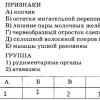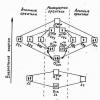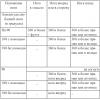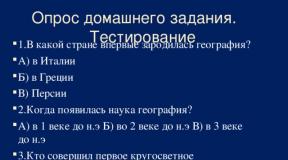Logarithmic equations. Solving logarithmic equations Logarithmic equations test
1 option
- 1. Find the product of the roots of the equation: log π (x 2 + 0.1) = 0
1) - 1,21; 2) - 0,9; 3) 0,81; 4) 1,21.
- 2. Indicate the interval to which the roots of the equation belong: log 0.5 (x - 9) = 1 + log 0.5 5
1) (11; 13); 2) (9; 11); 3) (-12; -10); 4) [ -10; -9 ].
- 3. Indicate the interval to which the root of the equation log 4 (4 - x) + log 4 x = 1 belongs
1) (-3; -1); 2) (0; 2); 3) [ 2; 3 ]; 4) [ 4; 8 ].
- 4. Find the sum of the roots of the equation log √3 x 2 = log √3 (9x - 20)
1) - 13; 2) - 5; 3) 5; 4) 9.
- 5. Indicate the interval to which the root of the equation log 1/3 (2x - 3) 5 = 15 belongs
1) [ -3; 2); 2) [ 2; 5); 3) [ 5; 8); 4) [ 8; 11).
- 6. . Indicate the interval to which the root of the equation lg (x + 7) - log (x + 5) = 1 belongs
1) (-∞; -7); 2) (-7; -5); 3) (-5; -3); 4) (0; +∞).
- 7. Solve the inequality log 3 (4 - 2x) >= 1
1) (-∞; 0,5 ]; 2) (-∞; 2 ]; 3) [ 2; + ∞); 4) [ 0,5; + ∞).
- 8. Solve the inequality log π (3x + 2)<= log π (х - 1)
1) (-2/3; + ∞); 2) (-∞; - 2/3 ]; 3) [ -1.5; - 2/3 ]; 4) there are no solutions.
- 9. Solve the inequality log 1/9 (6 - 0.3x) > -1
1) (-10; +∞); 2) (-∞; -10); 3) (-10; 20); 4) (-0,1; 20).
- 10. Find the number of integer negative solutions to the inequality lg (x + 5)<= 2 - lg 2
15; 2) 4; 3) 10; 4) none
Option 2
- 1. Find the product of the roots of the equation: lg (x 2 + 1) = 1
1) - 99; 2) - 9; 3) 33; 4) -33.
- 2. Indicate the interval to which the root of the equation log 4 (x - 5) = log 25 5 belongs
1) (-4; -2); 2) (6; 8); 3) (3; 6); 4) [ -8; -6 ].
- 3. Indicate the interval to which the root of the equation log 0.4 (5 - 2x) - log 0.4 2 = 1 belongs
1) (-∞; -2); 2) [ -2; 1 ]; 3) [ 1; 2 ]; 4) (2; +∞).
- 4. Find the sum of the roots of the equation log (4x - 3) = 2 log x
1) - 2; 2) 4; 3) -4; 4) 2.
- 5. Indicate the interval to which the root of the equation log 2 (64x²) = 6 belongs
1) [ 5; 7]; 2) [ 9; 11 ]; 3) (3; 5); 4) [ 1; 3 ].
- 6. . Indicate the interval to which the root of the equation belongs log 2 (x - 1)³ = 6 log 2 3
1) [ 0; 5); 2) [ 5; 8); 3) [ 8; 11); 4) [ 11; 14).
- 7. Solve the inequality log 0.8 (0.25 - 0.1x) > -1
1) (-∞; 2,5); 2) (-10; 2,5); 3) (2,5; + ∞); 4) (-10; + ∞).
- 8. Solve the inequality log 1.25 (0.8x + 0.4)<= - l
1) (-0,5; + ∞); 2) (-∞; - 0,5 ]; 3) (-0,5; 0,5 ]; 4) (-2; 2 ] .
- 9. Solve the inequality log 10/3 (1 - 1.4x)< -1
1) (0,5; +∞); 2) (-∞; 0,5); 3) (1,4; 2); 4) (0,5; 5/7).
- 10. Find the number of integer solutions to the inequality log 0.5 (x - 2) >= - 2
15; 2) 4; 3) infinitely many; 4) none.
Key
| A1 | A2 | A3 | A4 | A5 | A6 | A7 | B1 | B2 | C1 | |
|---|---|---|---|---|---|---|---|---|---|---|
| 1 option | 2 | 1 | 3 | 4 | 1 | 3 | 1 | 4 | 3 | 2 |
| Option 2 | 2 | 2 | 4 | 2 | 4 | 3 | 2 | 3 | 4 | 2 |






















1 of 22
Description of the presentation by individual slides:
Slide no. 1
Scientific manual on algebra Topic: “Logarithmic and exponential equations and inequalities” Completed by: Manuilova L.N. - mathematics teacher MBOU Secondary School No. 76, Izhevsk Udmurtia
Slide no. 2
Contents: Chapter 1. 1.1. The concept of logarithm 1.2. Properties of the logarithm 1.3. Logarithmic equations A. Theoretical part B. Examples 1.4. Logarithmic inequalities A. Theoretical part B. Examples Chapter 2. 2.1. The power of a positive number is 2.2. Exponential function 2.3. Exponential equations A. Theoretical part B. Examples 2.4. Exponential inequalities A. Theoretical part B. Examples Chapter 3. 3.1. Test on the topic “Logarithmic equations and inequalities” I level of complexity II level of complexity III level of complexity 3.2. Test on the topic “Exponential equations and inequalities” I level of complexity II level of complexity III level of complexity
Slide no. 3
1.1 The concept of logarithm y x y = b b M 1 0 n y = ax (a > 1) x y = ax (0< a < 1) y= b M 1 0 b у Для любого положительного числа b существует, и притом только одно, число n, такое, что b = an . Это число называют логарифмом числа b по основанию a. n Логарифмом положительного числа b по основанию a (a >0, a ≠ 0) is a number n such that b = an The logarithm of a positive number b to base a (a > 0,a ≠ 1) is denoted as follows: n = loga b From the definition of Logarithm it obviously follows that for a > 0 , a ≠ 1, b > 0: a loga b = b
Slide no. 4
Logarithmic function y y x x 1 2 2 1 1 1 -1 -1 2 2 -2 -2 3 0 0 y = log2 x y = log3 x y = log⅓x y = log½x The function y = loga x is called a logarithmic function. Properties of the function y = loga x, for a > 0: Continuous and increasing on the interval (0;+∞); If x→+∞, then y→+∞; if x→0, then y→ -∞. Since loga1=0, then from property 1 it follows: if x > 1, then y > 0; if 0< х < 1 ,то у < 0. Свойства функции y = loga x, при 0 < a < 1: Непрерывна и убывает на промежутке (0;+∞); Если х→ +∞, то у→ -∞; если х→0, то у→+∞. Так как loga1=0, то из свойства 1 следует: если х >1, then y< 0; если 0 < х < 1 ,то у >0.
Slide no. 5
Let a, M and N be positive numbers, with a ≠ 1, and k is a real number. Then the following equalities are true: 1. loga (M·N) = loga M + loga N - The logarithm of the product of positive numbers is equal to the sum of the logarithms of these numbers. 2. loga M = loga M – loga N - The logarithm of the quotient of positive numbers N is equal to the difference between the logarithms of the dividend and the divisor. 3. loga Mk = k · loga M - The logarithm of the power of a positive number is equal to the product of the exponent and the logarithm of this number. 4. loga M = logb M → loga b = 1 - Formula for converting logarithms from one logb a logb a base to another. Individual cases: 1. log10 b = log b - The base 10 logarithm of a positive number b is called the decimal logarithm of b. 2. loge b = ln b - The logarithm of a positive number b to base e is called the natural logarithm of b 1.2 Properties of logarithms
Slide no. 6
1. Let a be a given positive number not equal to 1, b be a given real number. Then the equation loga x = b is called the simplest logarithmic equation. For example, equations a) log3 x = 3 ; (1) b) log⅓ x = -2 ; (2) c) log25 x + 5·log4 x·log3 x + 7·log22 x = 0 ; (3) are the simplest logarithmic equations. By the definition of a logarithm, if a number x0 satisfies the numerical equality loga x = b, then the number x0 is ab, and this number x0 = ab is the only one. Thus, for any real number b, the equation loga x = b has a unique root x0 = ab. 2. Equations that, after replacing the unknown, turn into the simplest logarithmic equations: a) log5 (4x – 3) = 2; (4) b) 2 + 1 = -1 ; (5) log(3x + 1) + log0.01 log(3x + 1) 1.3 Equations (Theoretical part)
Slide no. 7
1.3 Examples log3 x = 3 Let us rewrite the equation in the form: log3 x = log3 27 Then it is obvious that this equation has a single root x0 = 27. Answer: 27. b) log1/3 x = -2 This equation has a single root x0 = ( ⅓)-2 =9 Answer: 9. c) log25 x + 5 · log4 x · log3 x + 7 · log22 x = 0 (1) Reducing all logarithms to the same base, we rewrite the equation as: 1 + 5 + 7 = 0 (2) log25 x · log5 4 · log5 3 log25 2 Since each term of the sum enclosed in parentheses is positive, the sum is not equal to zero. Therefore, equation (1), and therefore equation (2), are equivalent to the equation log25 x = 0, which has a single root x0 = 1. Therefore, equation (1) has a single root x0 = 1. Answer: 1. a, b – the simplest equations; c is an equation that, after transformations, turns into the simplest log. the equation
Slide no. 8
1.3 Examples a) log5 (4x – 3) = 2 (1) Introducing the new known t = 4x – 3, we rewrite the equation in the form: log5 t = 2. This equation has a single root t1 = 52 =25. To find the root of equation (1), you need to solve the equation: 4x – 3 = 25. (2) It has a single root x1 =7. Therefore, equation (1) also has a single root x1=7. Answer: 7. b) 2 + 1 = -1 (1) log(3x + 1) + log0.01 log(3x + 1) Introducing a new unknown t = log (3x + 1) and taking into account that log 0.01 = -2, we rewrite equation (1) in the form: 2 + 1 = -1 (2) t - 2 t Having solved the rational equation (2), we find that it has two roots t1 = -2 and t2 = 1. To find all roots of equation (1), it is necessary to combine the roots of the two equations log(3x + 1) = -2 and log(3x + 1) = 1. The first equation is equivalent to the equation 3x + 1 = 10-2, which has a single root x1 = -0.33. The second equation is equivalent to the equation 3x + 1 = 10, which also has a single root x2 = 3. Answer: -0.33 ; 3. a, b – equations reduced to the simplest by replacing the unknown
Slide no. 9
1.4 Inequalities (Theoretical part) Let a be a given positive number not equal to 1, b be a given real number. Then the inequalities: logа x > b (1) logа x< b (2) являются простейшими логарифмическими неравенствами. Неравенства (1) и (2) можно переписать в виде: loga x >loga x0 (3) loga x< loga x0 (4) , где x0 = ab . Если a >1, then the function y = loga x increases over its entire domain of definition, i.e. on the interval (0;+∞). Therefore, for any number x > x0 the numerical inequality loga x > loga x0 is true, and for any number x from the interval 0< x < x0 справедливо числовое неравенство logа x < logа x0 . Кроме того, равенство logа x = logа x0 справедливо лишь при х = х0 . Таким образом, при а >1 and any real number b, the set of all solutions to inequality (3) is the interval (x0 ;+ ∞), and the set of all solutions to inequality (4) is the interval (0; x0). If 0< a < 1, то функция y = loga х убывает. Поэтому для любого числа x >x0 the numerical inequality loga x is true< loga x0 , а для любого числа х из промежутка 0 < x < x0 справедливо числовое неравенство loga x >loga x0 . In addition, the equality loga x = loga x0 is valid only for x = x0. Thus, at 0< a < 1 и любом действительном числе b множество всех решений неравенства (3) есть интервал (0; х0) , а множество всех решений неравенства (4) есть интервал (х0 ;+∞).
Slide no. 10
1.4 Inequalities (Theoretical part) On the coordinate plane xOy, consider the graphs of the function y = loga x and y = b. The straight line y = b intersects the graph of the function y = loga x at a single point x0 = ab. If a > 1, then for each x > x0 the corresponding point on the graph of the function y = loga x is located above the straight line y = b, i.e. for each x > x0 the corresponding ordinate y = ax is greater than the ordinate ax0, and for each x from the interval 0< x < x0 соответствующая точка графика функции y = loga x находится ниже прямой y = b. Если же 0 < a <1, то, наоборот, для каждого x >x0 the corresponding point on the graph of the function y = loga x is below the straight line y = b, and for each x of the intervals 0< x < x0 соответствующая точка графика функции y = loga x находится выше прямой y = b. у у х х 1 1 1 1 х0 0 0 y = b y = loga x (a >1) y = b y = loga x (0< a < 1) х0
Slide no. 11
1.4 Examples Let us solve the inequality log1/3 x > -2. (1) Since -2 = log⅓ 9, then inequality (1) can be rewritten as log ⅓x > log ⅓ 9 (2) Since ⅓< 1, то функция y = log⅓ x убывающая. Поэтому множество всех решений неравенства (2), а значит и неравенства (1), есть интервал 0 < x <9. Ответ: (0;9). 2. Решим неравенство log4 x >½. (3) Since ½ = log4 2, then inequality (3) can be rewritten as log4 x > log4 2 (4) Since 4 > 1, then the function y = log4 x is increasing. Therefore, the set of all solutions to inequality (4), and therefore to inequality (3), is the interval (2;+∞). Answer: (2;+∞). (see Fig. 1) x y 1 2 3 4 1 -1 0 Fig. 1 y = ½ y = log4 x
Slide no. 12
1.4 Examples Let us solve the inequality log3 x – 3log9 x – log81 x > 1.5. (5) Since log9 x = (log3 x) / (log3 9) = (log3 x) / 2 = ½ (log3 x), log81 x = (log3 x) / (log3 81) = (log3 x) / 4 = ¼ (log3 x), then inequality (5) can be rewritten as: (1 – 1.5 – ¼) log3 x > 1.5 or as log3 x< log3 1/9. (6) Так как 3 >1, then the function y = log3 x is increasing. Therefore, the set of all solutions to inequality (6), and hence inequality (5), is the interval 0< x < 1/9 (рис.2) Ответ: (0 ; 1/9). y x 1 2 0 -1 y = log3 x y = -2 (рис.2) 1/9
Slide no. 13
2.1 Power of a positive number Power with a rational exponent Let a be a positive number and p/q a rational number (q ≥ 2). By definition, the number a to the power p/q is the arithmetic root of the power q of a to the power p, i.e. a p/q = q√ap . THEOREM. Let a be a positive number, p an integer, k and q natural numbers, q ≥ 2, k ≥ 2. Then the following equalities are true: a) ap/q = (a1/p)p ; b) ap/q = a pk /qk ; c) ap = a pq /q ; Properties of a degree with a rational exponent THEOREM 1. A positive number a to a degree with any rational exponent r is positive: ar > 0 THEOREM 2. Let a be a positive number, and r1, r2 and r are rational numbers. Then the following properties are true: 1. When multiplying powers with rational exponents of the same positive number, the exponents add: аr1 ∙ аr2 = аr1 + r2. 2. When dividing powers with rational exponents of the same positive number, the exponents are subtracted: аr1: аr2 = аr1 – r2. 3. When raising a power with a rational exponent of a positive number to a rational power, the exponents are multiplied: (a r1) r2 = a r1∙ r2. THEOREM 3. Let a and b be positive numbers and r a rational number. Then the following properties of a degree with a rational exponent are valid: A degree with a rational exponent of the product of positive numbers is equal to the product of the same powers of the factors: (ab)r = ar ∙ br . The power with a rational exponent of the quotient of positive numbers is equal to the quotient of the same powers of the dividend and divisor: (a / b)r = ar / br. THEOREM 4. Let the number a > 1, and r be a rational number. Then ar > 1 for r > 0 0< ar < 1 при r < 0 ТЕОРЕМА 5. Пусть число a >1, and the rational numbers r1 and r2 satisfy the inequality r1< r2 . Тогда a r1 < a r2 . ТЕОРЕМА 6. Пусть число a принадлежит интервалу (0;1), а рациональные числа r1 и r2 удовлетворяют неравенству r1< r2 . Тогда a r1 < a r2 .
Slide no. 14
2.2 Exponential function Consider the function y = a (1) , where a > 0 and a ≠ 0, on the set of rational numbers. For every rational number r, a number ar is defined. This is how function (1) is defined for now on the set of rational numbers. The graph of this function in the coordinate system x0y is a collection of points (x; ax), where x is any rational number. For a > 1, this graph is shown schematically in Figure (1), and for 0< a < 1 – на рисунке (2). у у x x 1 2 1 2 3 -2 -1 -2 -1 0 1 1 2 2 Рис. 1 Рис. 2 Её называют показательной функцией с основанием а.
Slide no. 15
2.3 Exponential equations (Theoretical part) 1. Let a be a given positive number not equal to 1, b be a given real number. Then the equation ax = b (1) is called the simplest exponential equation. For example, the equations 2x = 8, (1/3)x = 9, 25x = -25 are the simplest exponential equations. The root (or solution) of an equation with an unknown x is the number x0, when substituting it into the equation instead of x, the correct numerical equality is obtained. Solving an equation means finding all its roots or showing that there are none. Since ax0 > 0 for any real number x0 for which the numerical equality ax0 = b would be true, the unique number x0 = loga b satisfies. Thus, equation (1): For b ≤ 0 has no roots; For b > 0, it has a single root x0 = loga b. 2. Equations that, after replacing the unknown, turn into the simplest exponential equations.
Slide no. 16
2.3 Examples Let us solve the equation (1/2)x = 2 (2) Since 2 > 1, this equation has a single root x0 = log½ 2 = -1. Answer: -1. Let's solve the equation 3x = 5 (3) Since 5 > 0, this equation has a single root x0 = log3 5. Answer: log3 5. Solve the equation 25x = -25 Since -25< 0, то это уравнение не имеет корней. Ответ: нет корней. Для отыскания корня уравнения ax = b (1) при b >0 this equation is often written as ax = aα, where α = loga b. Then it is obvious that the only root of this equation, and therefore of equation (1), is the number α. Since equation (2) can be written in the form (1/2)x = (1/2)-1, then its only root is x0 = -1. Since equation (3) can be written as 3x = 3log 35, its only root is x0 = log3 5.
Slide no. 17
2.3 Examples Now let's look at equations that, after simple transformations, turn into simple exponential equations. Let's solve the equation 5x+2 - 2 5x - 3 5x+1 = 200 (4) Since 5x+2 = 25 5x, 5x+1 = 5 5x, then equation (4) can be rewritten as 5x ( 25 - 2 – 15) = 200 or in the form 5x = 52 (5) It is obvious that equation (5), and therefore equation (4), have a single root x0 = 2. Answer: 2. Solve the equation 4 3x - 9 2x = 0 (6) Since 2x ≠ 0 for any real number, then dividing equation (6) by 2x, we obtain the equation 4 (3/2)x - 9 = 0, (7) equivalent to equation (6 ). Equation (7) can be rewritten as (3/2)x = (3/2)2. (8) Since equation (8) has a single root x0 = 2, then the equivalent equation (6) has a single root x0 = 2. Answer: 2.
Slide no. 18
2.3 Examples Let us solve the equation 9 2x2-4x + 2 - 2 · 34x2 – 8x + 3 -1 = 0. (9) Having rewritten equation (9) in the form 34x2 – 8x + 3 = 1, we introduce a new unknown t = 4x2 – 8x + 3. Then equation (9) can be rewritten in the form 3t = 1. (10) Since equation (10 ) has a single root t1 = 0, then in order to find the roots of equation (9), it is necessary to solve the equation 4x2 – 8x + 3 = 0. This equation has two roots x1 = 1/2, x2 = 3/2, so the equation (9) has the same roots. Answer: 1/2 ; 3/2. Now consider solving equations that, after introducing a new unknown t, turn into quadratic or rational equations with unknown t. Let's solve the equation 4x - 3 2x + 2 = 0. (11) Since 4x = (2x)2, then equation (11) can be rewritten as (2x)2 - 3 2x + 2 = 0. By introducing a new unknown t = 2x, we obtain a quadratic equation t2 - 3t + 2 = 0, which has two roots t1 = 1, t2 = 2. Therefore, to find all the roots of equation (11), we need to combine all the roots of the two equations 2x = 1 and 2x = 2 Having solved these simple exponential equations, we find that all the roots of equation (11) are x1 = 0; x2 = 1. Answer: 0; 1 .
Slide no. 19
2.4 Exponential inequalities (Theoretical part) Let a be a given positive number not equal to 1, b be a given real number. Then the inequalities ax > b (1) and ax< b (2) называют простейшими показательными неравенствами. Например, неравенства: 2x < 3 , (1/3)x >4√3, 25x< -25 являются простейшими показательными неравенствами. Решением неравенства с неизвестным х называют число х0 , при подстановке которого в неравенство вместо х получается верное числовое неравенство. Решить неравенство - значит найти все его решения или показать, что их нет. Поскольку a x0 >0 for any real number x0, then for b ≤ 0 the inequality a x0 > b is true for any real number x0, but there is not a single real number x0 for which the numerical inequality a x0 would be true< b . Таким образом, если b ≤ 0 , то множество всех решений неравенства (1) есть интервал (-∞;+∞), а неравенство (2) решений не имеет. Если же b >0, then inequality (1) and (2) can be rewritten as ax > ax0 (1) and ax< ax0 , (2) , где х0 = loga b. Рассмотрим решение неравенств (3) и (4) сначала при а >1. Since for such a the function y = ax is increasing, then for any number x > > ax0, and for any number x > x0 the numerical inequality ax is true< ax0 . Кроме того, равенство ax = ax0 справедливо лишь при х = x0 .
Slide no. 20
2.4 Exponential inequalities (Theoretical part) Thus, for b > 0 and a > 1, the set of all solutions to inequality (3) is the interval (x0 ;+∞), and the set of all solutions to inequality (4) is the interval (-∞; x0) , where x0 = loga b. Let now 0< a < 1. Так как для такого а функция y = aх является убывающей, то для любого числа х >x0 the numerical inequality ax is true< ax0 . Кроме того, равенство ax = ax0 справедливо лишь при х = x0 . Таким образом, при b >0 and 0< a < 1 множество всех решений неравенства (3) есть интервал (-∞; x0), а множество всех решений неравенства (4) есть интервал (x0 ;+∞), где x0 = loga b. Приведенное выше решение простейших показательных неравенств можно дополнить графической иллюстрацией. Рассмотрим графики функций y = aх и y = b. Ясно, что при b ≤ 0 прямая y = b не пересекает график функции y = aх, так как расположена под кривой y = aх (а, б). Поэтому для любых х выполняется неравенство ax >b and there are no x for which the inequality ax< b . При b >0 straight line y = b intersects the graph of the function y = aх at a single point x0 = loga b. 1 y y x x y = 0 y = 0 y = ax (a > 1) 0 1 y = b (b< 0) y = b (b < 0) 1 0 1 y = ax (0 < a < 1) a) б)
Slide no. 22
2.4 Examples Solve the inequality 2x< 8 . (1) Так как 8 >0, then inequality (1) can be rewritten as 2x< 23. (2) Так как 2 >1, then the function y = 2x is increasing. Therefore, solutions to inequality (2), and therefore to inequality (1), are all x< 3. Ответ: (-∞; 3). Решим неравенство (1/3)х < 5 . (3) Так как 5 >0, then this inequality (3) can be rewritten as (1/3) x< (1/3) log⅓ 5 . (4) Так как 0 < 1/3 < 1, то функция y = (1/3)x убывающая. Поэтому решениями неравенства (4), а значит и неравенства (3), являются все х >log⅓5. Answer: (log⅓ 5; +∞). Let us consider an inequality that, after replacing the unknown, turns into the simplest exponential inequality. Let's solve the inequality 5 3x2 - 2x – 6< 1/5 . (5) Введя новое неизвестное t = 3x2 - 2x – 6, перепишем неравенство (5) в виде 5t < 5-1 . Так как 5 >1, then all solutions to this inequality are all t< -1. следовательно, все решения неравенства (5) есть решения неравенства 3x2 - 2x – 6 < -1. (6) Решив квадратное неравенство (6), найдем все его решения: -1 < x < 5/3 . Они являются решениями неравенства (5). Ответ: (-1 ; 5/3).
- ensure repetition, generalization, systematization of material on the topic;
- create conditions for control and self-control of acquired knowledge and skills;
- promote the formation of skills to apply techniques: comparison, generalization, highlighting the main thing, transferring knowledge to a new situation, developing a mathematical outlook;
- create conditions for the development of students’ cognitive interest;
- to cultivate responsibility for the quality and result of the work performed in the lesson, mathematical activity, the ability to work in groups, and general culture.
- Review theoretical material. Pay special attention to the ODZ of the logarithmic function.
- Systematize methods for solving logarithmic equations.
- Carry out knowledge diagnostics.
Lesson type: lesson of generalization and systematization of knowledge.
Lesson format: workshop
Equipment: textbook, teaching materials, individual cards for independent work, knowledge recording sheets, media projector.
During the classes
1. Organizational moment
Students are informed of the topic of the lesson and goals, and the relevance of repeating this topic to prepare for the Unified State Exam is emphasized.
2. Checking homework
3. Updating previous knowledge
Students work orally on exercises presented on the screen using a projector.
Calculate
1 option 2)
Option 2 2)
3)
5)
4. Formation of skills and abilities.
Work in groups followed by testing.
1) Solving logarithmic equations by defining the logarithm.
Answer:Answer: 256
2) Equations solved by potentiation.
First, you need to solve the equation of the system, and based on the inequality of the system, the roots are selected.
Answer: 3
Answer: 3,5Equations solved by substitution.
Answer:
This equation is equivalent to the equation
Let it be then
Answer:
Equations solved by logarithm.
=So Answer: 0,1; 10..
.
ODZ: x. Let's take logarithms of both sides to base 10.
Where
Answer: 1; 4.
Equations of the form
This equation is equivalent to the equation for
.
DZ is determined by the system
DZ is determined by the system
Answer: ( (0;)

Equations solved using various properties of logarithms.
Applying the formula, we get
Substituting these values of x into the original equation, we see that is the root of the equation, and 0.1 is not the root of the equation.
Answer:
Those equations that caused difficulties for students are solved on the board by students who have completed them.
5. Physical education minute
They clasped their hands in a “lock”, stretched them out in front of them, raised them up and stretched well. Doctors say that at this moment the “enzyme of happiness” is released.
6. Independent work
(Slide on the screen and cards for each student). Students are asked to evaluate their capabilities and choose task level A, B or C.
After completing the work, students submit it for testing. The answers and a short solution are displayed on the screen. Students are encouraged to check and evaluate their work by assigning a mark for independent work.
6. Homework
Repeat P.6.2, 6.3. D.M. C – 21 No. 2 (b, c), No. 3 (d, e) options 3 and 4.
7. Lesson summary
So, today we solved logarithmic equations. Now let's summarize what methods we used to solve equations:
- using the definition of logarithm,
- using the basic logarithmic identity,
- using the potentiation method,
- introducing a new variable,
- transition from an equation with different bases to one base,
- using the properties of the logarithm.
Giving marks based on the number of “+” in the notebook, for the solution on the board and on the cards. Determining student performance.
Our lesson has come to an end. Have we achieved our goals?
Time flies unnoticed, today you are tenth graders, and tomorrow you are already graduates. When preparing for an exam, never think that you will not cope with the task, but, on the contrary, mentally paint yourself a picture of success and then you will definitely succeed!
Literature:
- Nikolsky S.M., Potapov M.K., Reshetnikov N.N., Shevkin A.V.. Algebra and beginning of mathematical analysis. Grade 10. Textbook for general education institutions: basic and specialized levels. – M., 2009
- Potapov M.K., Shevkin A.V.. Algebra and beginning of mathematical analysis. Didactic materials for grade 10. – M., 2009.
- Shepeleva Yu.V.. Algebra and beginning of mathematical analysis. Thematic and final tests for grade 10. – M., 2009.
- Lysenko F.F.. Mathematics Unified State Exam-2009. Legion. – M., 2009.
- Klovo A.G.. Mathematics Unified State Exam-2010 - M., 2010.
- Erina T.M. Algebra. Logarithmic equations and inequalities - M, 2004.
the main objective when working with the offered tickets:
- teach students to see the commonality in solving the corresponding equations and inequalities and the differences when writing answers;
- saving time;
- ability to navigate the content of this material.
If the first goal does not raise questions, then the time savings are not immediately felt. Although it was the lack of time that affected the ticket structure. They are compiled according to the same principle. Equations and inequalities are arranged so that it is easier to establish correspondence between them.
And despite the teacher’s recommendation: to solve the equation and immediately follow it with a solution to the corresponding inequality, half of the students preferred to first solve all the equations from the first column, and then start solving the inequalities. When writing down the answer, pay attention to the fact that due to the absence of roots in the equation, it does not follow that the inequality will have no solutions.
When passing the second test, no such problems arose, since many had developed the ability to “see” and developed certain skills.
In each ticket, the material is selected so that, in addition to equations (inequalities) solved by definition and properties, there are equations (inequalities) solved by factorization; changing variables. And, naturally, the solution of quadratic equations and inequalities of the second degree is repeated.
There are only 26 tasks in the tickets. Therefore, students were offered the following standards: “5” – 26 ass. , “4” – 19–25 ass. , “3” – 14–18 ass. , “2” – less than 14 ass.
A student applying for a grade of “5” must have time to solve all the equations and inequalities during the lesson. The first fourteen tasks are the required minimum. Of course, the test can be retaken. But it is advisable to do it within the allotted time.
When preparing for the Unified State Exam, when the skills for solving equations (inequalities) have already been developed, tasks can be replaced. For example, these:
- indicate the sum (product) of the roots of the equation;
- indicate the smallest (largest) root of the equation;
- find the smallest (largest) integer solution to the inequality;
- find the sum (product) of integer solutions to the inequality.
Of course, each teacher can add to this list himself. Depending on the class, it becomes necessary to pay more attention to some tasks and less to others.
Tickets can be used both for tests and for independent work. Each ticket consists of two blocks: basic level (1st level) and advanced (2nd level). The block consists of two parts: equations and inequalities, which are divided into two columns to make it easier for the student to establish correspondence between them.
Below are six ticket options for each topic. Answers have been given to them.
Annex 1. Logarithmic equations and inequalities.
Appendix 2. Exponential equations and inequalities.
Appendix 3. Answers to tickets on algebra and beginnings of analysis.
Logarithmic equations, their types and methods of solution Concentration of attention: Concentration of attention is equal to N. N = (number of correct answers) x 0.125 x 100%. Write down a special case of the formula for passing to the logarithm of another base. Write down the formula for passing to the logarithm of another base. What is the logarithm of a power of a number and a base? What is the logarithm of the base? What is the logarithm of a power of a number? What is the logarithm of the quotient? What is the logarithm of the product? Formulate the definition of logarithm Answer Question
Let's consider the relative position of the graph of the function y = log a x (a > 0, a ≠ 1) and the straight line y = b. y = log a x (a>1) y x 0 y = log a x (0
Logarithmic equations, their types and methods for solving CONCLUSION: The graph of the function y = log a x (a > 0, a ≠ 1) and the straight line y = b intersect at a single point, i.e. the equation log a x = b, a > 0, a ≠ 1, x > 0 has a unique solution x 0 = a b.
DEFINITION: The equation log a x = b, a > 0, a ≠ 1, x > 0 is called the simplest logarithmic equation. Logarithmic equations, their types and methods of solution Example:
Types and methods of solving logarithmic equations. DEFINITION: Logarithmic equations are those containing an unknown under the logarithm sign or at the base of the logarithm (or both). Logarithmic equations, their types and methods of solution
Types and methods of solving logarithmic equations. ADDENDUM: When solving logarithmic equations, it is necessary to take into account: the range of permissible values of the logarithm: only positive values can be under the sign of the logarithm; at the base of logarithms there are only positive quantities different from unity; properties of logarithms; potentiation action. Logarithmic equations, their types and methods of solution
Logarithmic equations, their types and methods for solving Types and methods for solving logarithmic equations. 1) The simplest logarithmic equations. Example No. 1 Answer: Solution:
Logarithmic equations, their types and methods for solving Types and methods for solving logarithmic equations. 2) Logarithmic equations, reduced to the simplest logarithmic equations. Example No. 1 Answer: Solution:
Logarithmic equations, their types and methods for solving Types and methods for solving logarithmic equations. 2) Logarithmic equations, reduced to the simplest logarithmic equations. Example No. 2 Answer: Solution:
Logarithmic equations, their types and methods for solving Types and methods for solving logarithmic equations. 2) Logarithmic equations, reduced to the simplest logarithmic equations. Example No. 3 Answer: Solution:
Logarithmic equations, their types and methods for solving Types and methods for solving logarithmic equations. 2) Logarithmic equations, reduced to the simplest logarithmic equations. Example No. 4 Answer: Solution:
Logarithmic equations, their types and methods for solving Types and methods for solving logarithmic equations. 3) Logarithmic equations reducing to quadratic equations. Example No. 1 Answer: Solution:
Logarithmic equations, their types and methods for solving Types and methods for solving logarithmic equations. 3) Logarithmic equations reducing to quadratic equations. Example No. 2 Answer: Solution: In the found range of permissible values of the variable x, we transform the equation using the properties of logarithms. Taking into account the range of acceptable values, we obtain: 10; 100
Logarithmic equations, their types and methods for solving Types and methods for solving logarithmic equations. 4) Logarithmic equations, reducing to rational equations. Example No. 1 Answer: Solution: Let's return to the variable x
Logarithmic equations, their types and methods for solving Types and methods for solving logarithmic equations. 4) Logarithmic equations, reducing to rational equations. Example No. 2 Answer: Solution: In the found range of permissible values of the variable x, we transform this equation and get: Let's return to the variable x:
Logarithmic equations, their types and methods for solving Types and methods for solving logarithmic equations. 5) Logarithmic equations with a variable in the base and under the logarithm sign. Example No. 1 Answer: Solution: In the found range of permissible values of the variable x, we transform the equation and obtain: Taking into account the range of permissible values of the variable x, we obtain:
Logarithmic equations, their types and methods for solving Types and methods for solving logarithmic equations. 5) Logarithmic equations with a variable in the base and under the logarithm sign. Example No. 2 Answer: Solution: In the found range of permissible values of the variable x, the equation is equivalent to the set: Taking into account the range of permissible values of the variable x, we obtain: 5;6.
Logarithmic equations, their types and methods of solution



















